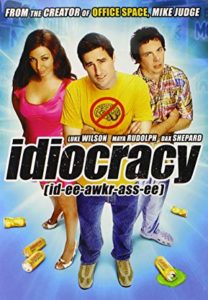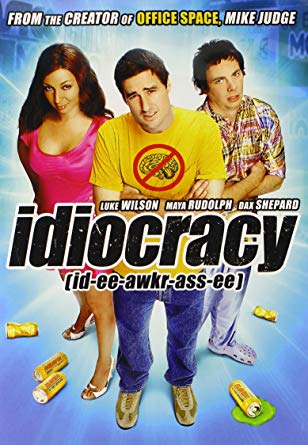Sherin Nicole: Life Imitates Art in “Idiocracy” and “Terminator 2”
Posted on December 3, 2018 at 12:16 pm

My friend and fellow critic Sherin Nicole wrote a perceptive and thoughtful essay for The Black List about two movies considered to be wildly imaginative when they were released that now seem eerily accurate in predicting where we are now. She calls them Essential Political Films.
She begins with Idiocracy, which it’s star Dax Shepard jokingly calls a “documentary,” the wildly satiric story of a present-day time traveler who arrives in an America of 2505 to find that everyone is corrupt and, well, idiots. Nicole writes:
IDIOCRACY worried me in 2006 because it seemed plausible. We already had criminals pleading not guilty to crimes because they “were shooting reality TV shows.” Intelligence had begun to be a liability; people would fight you if you made them feel dumb. And beverages at the movies were served in plastic buckets so large you could pour a 2-liter into them and still have room for ice cream.
However, IDIOCRACY didn’t become an Essential Political film until 2016. Looking back on it from today’s vantage point, Mike Judge didn’t make a stupid slapstick throwaway, he made a smart satire about “how stupid we peeples r.” Sounds ridiculous, I know, but there are several parallels between Judge’s 2505 and our now: Logic and reason are shot down while lies and nonsense are repeated. Bullying and misogyny are desirable traits in a politician. We’ve gone back to glyphs to express ourselves. Reality TV stars are revered as purveyors of culture. And the kicker, the president is a wrestling enthusiast, former reality TV star who uses foul language and fouler gestures, incites violence, and has inexplicable hair.
And then there’s Night of the Living Dead. When it was released, no one realized that a low-budget horror film would be so influential, inspiring an entirely new genre of zombie films. And its filmmakers did not realize how revolutionary it was to cast a black man as the lead actor and hero of the film and how prescient the ending would be. She writes:
Yet, the final scenes are where NIGHT OF THE LIVING DEAD truly leaves a mark. After repeatedly risking himself to save his comrades from a horde of ravenous dead, Ben finally survives the night. Help arrives as the local sheriff and a group of militiamen sweep the area. As a viewer you feel a sense of relief — our guy made it through — but when Ben approaches a boarded up window, the darkened lighting tells us something is wrong. One of the militiamen sees Ben’s silhouette and fires his shotgun, putting a bullet through our hero’s forehead. He’s a good guy with a gun but they kill him and they burn him the same as the monsters.
Fifty years later and earlier this month, armed security guard Jemel Roberson had successfully subdued a violent shooter outside the bar where he worked in the suburbs of Chicago. Those who were wounded that day must have felt such relief when Roberson stopped their attacker. More help came afterward but not for their rescuer. When officers arrived on the scene they shot Jemel Roberson dead. He was a good guy with a gun. A black-American hero. They shot him anyway.
The parallels are painful.
The essay is highly recommended. And all of us should think about what movies today we think will and should give us insight not only into where we are now but into where we are going.

